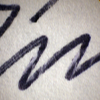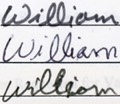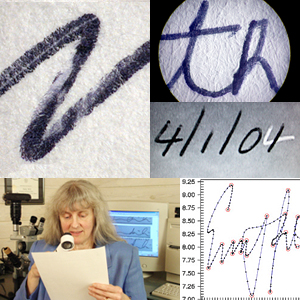Board Certified Forensic Document Examiner specializing in handwriting identification and suspect documents.
Emily J. Will, D-BFDE
Theory: Handwriting and Signatures - Some basic facts and theory
1. The Physiology of Handwriting Production

Let's look at how a human learns to use his or her brain and nervous system to write. Appreciation is extended to Dr. Bryan Found and Dr. Doug Rogers at the Forensic Expertise Profiling Laboratory, School of Human Biosciences at LaTrobe University, Australia, for their voluminous work in this area and for disseminating most of the following information in articles and professional presentations.
2. Automatic Abilities Grow into Patterns

Smiling is a simple behavior that a baby learns early in life. First, he imitates his parents' smiles. As smiles are rewarded by more smiles and hugs from his parents (positive feedback), a pattern is built. Soon, smiling becomes automatic, like breathing. Similarly, the baby learns to reach, grasp, speak and walk. Handwriting is a very complex motor task, not usually learned until the child is 5 or 6 years old and has mastered simpler skills.
3. The Motor Control System

4. Handwriting

5. Experiment

6. Body as a Machine

7. Variety: The Natural Range of Handwriting


Handwriting can also be affected by other factors - injury, illness, medication, drug or alcohol use, stress, the writing surface, the writing instrument, or attempted disguise. It is the job of the document examiner to understand these factors as they might relate to a specific situation.

Actually, every person has a range of handwriting variation determined by his or her physical writing ability, training in "penmanship", and other factors. To the experienced expert, a study of known samples of writing can reveal a cluster of individual writing characteristics which can allow the expert to identify or exclude an individual as the author of some questioned writing.
What a forensic document examiner can't tell you about handwriting:

Handedness - Right or Left?
While there are indicators that point to right or left handedness, it is not possible to be certain that the writing was executed with the right or left hand.

Gender
Again, while there are indicators that might be more associated with male or female handwriting, it is not possible to be certain of the gender of the writer.

Age
Yes, there are features often associated with the writing of older or younger people, but there is too much crossover to allow for any certainty about the age of the writer.
